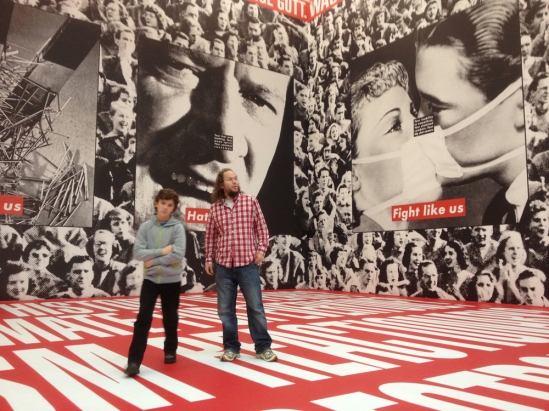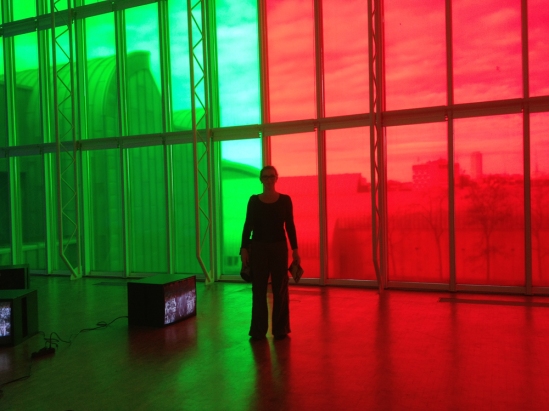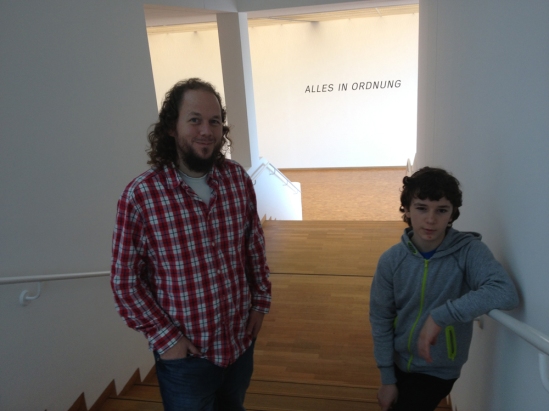
This weekend I had the pleasure of visiting the Museum Ludwig in Cologne, which is currently showing an exhibit called “Adjusted,” comprising a range of works by the American “Pictures Generation” artist Louise Lawler, alongside an all new permanent exhibition called “Not Yet Titled: Neu und für immer im Museum Ludwig” [Not Yet Titled: New and Forever in Museum Ludwig]. Apparently, the latter is less a permanent exhibition in the traditional sense, and more a semi-permanent configuration of museum space whose contents are scheduled to change; accordingly, it is not so much the artworks on display at any moment that constitute the object of the exhibition but rather the museum itself, its spaces and practices of exhibition, so that “Not Yet Titled” seems to defer closure in the interest of staging a quasi-permanent exhibition of flux. That’s a fairly self-reflexive undertaking, as are many of the works on display, so it’s especially refreshing to see that the museum manages to combine all this heady cross- and self-referencing with a material lightness, an architectural and visceral deferral of (en)closure that is all too often lacking in exhibitions of postmodern and semiotically complex works.

One of the exhibition’s centerpieces, Barbara Kruger’s large-scale untitled installation from 1994/1995, which you see at the top of this post (but which you also have to hear in order to appreciate fully), is a case in point: the dense commentary on our media culture, its reflexive irony and intertextuality, are embedded in a space that is at once overloaded and threatening and yet therapeutically soothing as well. The ecstatic sounds of a crowd cheering at the absurd acceptance speech for some unnamed award, where the awardee thanks his God and plays with dictatorial slogans, brainwashing tactics, sexist stereotypes and racist claims of superiority — all of these we register cognitively and appraise their political significance, but the applause enervates us directly, dangerously, on this open stage that seems as if it were designed to highlight the problematic political phenomenology of contemporary spaces: While immersed in the installation, we are able to feel the rich ambivalence of its space, which invites us both to recognize the coded nature of experience while also experiencing something that feels like a space for reflection; but the most surprising aspect of the space can only be grasped later, in a snapshot like mine above: Kruger’s installation, which positively begs to be remediated in the form of a photograph (while flaunting the fact that it can never be captured or encompassed in one), immediately collapses into a flat background, against which the human figure inevitably seems to have been added in later with Photoshop. (I swear, the picture above has not been retouched!)
Not only in Kruger’s installation, but throughout the permanent and temporary exhibitions, it was space that, for me, constituted the true attraction. Lawler’s highly self-reflexive photographs of other artists’ artworks (de- and re-contextualized to highlight the significance of exhibition practices and spatial orders) vacillated between a challenging semiotic complexity and a pleasant, almost banal decorative quality within the large open spaces of the Ludwig. Particularly refreshing was the newly commissioned Tracings series, which carries Lawler’s self-reflexive and intertextual tendencies further but abstracts them, reduces, and contributes to a clear open space. In this series, Lawler’s photos of other people’s art are reproduced again, but now in the simplified form of black contour lines upon a white background, thus transforming the high-resolution photographs and rendering the works more iconic and approachable. These oversized coloring-book pictures, which we survey upon exiting the smaller exhibition rooms in the wide monochromatic space in which we access the stairs, refer, of course, to the images we saw downstairs, but they also seem happy enough to slip into the background and assume a more functional, properly architectural role that does not force any sort of dialogue or commentary. Likewise, Lawler’s new Stretch images, which take Andy Warhol’s famous Brillo boxes as their “subject,” blown up to gigantic proportions to occupy two complete walls with anamorphically stretched photos, emphasize the space of the museum — both as an institution and as a material environment.
All in all, the current showings at the Museum Ludwig offer lots of food for thought — for reflection on the politics, history, and institution of contemporary art, for theoretically guided musings on the relations of art to mass media and our changing media of reproduction, and for thought about our own place within these configurations. If that’s what you’re looking for, you’re sure to be happy here. These exhibitions do more, though, as well, and something that many museums fail to do as they aim for more “interactive” forms of engagement (while misunderstanding “interactive” as “overstuffed and preemptively overladen with information”): namely, Lawler’s “Adjusted” and the (quasi-)permanent “Not Yet Titled” grasp the space of their own staging, clear it out for our experience, and remind us that we are bodies moving through space and time. Architectural space becomes affective space, and this affective space collides ambiguously with the content of the artworks displayed. The latter may make us know, on a cognitive and political level, that everything is not OK, but even just registering that in this wonderful space imparts a (not unproblematic) feeling, a not yet titled affect: “Alles in Ordnung” (irgendwie, vielleicht)…






